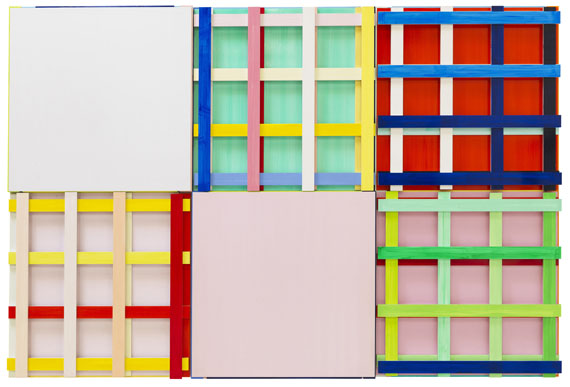227
Imi Knoebel
LILOLA, 2002.
Acrylic on aluminum
Estimate:
€ 200,000 / $ 236,000 Sold:
€ 275,000 / $ 324,500 (incl. surcharge)
LILOLA. 2002.
Acrylic on aluminum.
Signed, dated and titled on the reverse. 304 x 456 x 10.5 cm (119.6 x 179.5 x 4.1 in).
• Monumental unique object with a remarkable spatial effect and radiance.
• Works in this size are extremely rare in Knoebel's creation.
• Largest work offered on the international auction market to date.
• A similar composition featured the grand Knoebel Retrospective at Kunstmuseum Wolfsburg in 2014.
• Works by Imi Knoebel are in many important international collections like the Museum of Modern Art, New York, the Hamburger Bahnhof, Museum für Gegenwart, Berlin, the Pinakothek der Moderne, Munich and the Albertina Vienna.
PROVENANCE: Galerie Helga de Alvear, Madrid.
Privatse collection Hesse (acquired from the above).
EXHIBITION: Kestner-Gesellschaft, Hanover 2002 (with the label on the reverse).
"Imi Knoebel is one of today's most radical abstract artists [..] his work combines radicalness and consistency in a balanced unity that is put to the test time and again."
Zdenek Felix, quoted after: Imi Knoebel. Retrospektive 1968-1996, ex. cat. Haus der Kunst, Munich 1996, pp. 291f.
Acrylic on aluminum.
Signed, dated and titled on the reverse. 304 x 456 x 10.5 cm (119.6 x 179.5 x 4.1 in).
• Monumental unique object with a remarkable spatial effect and radiance.
• Works in this size are extremely rare in Knoebel's creation.
• Largest work offered on the international auction market to date.
• A similar composition featured the grand Knoebel Retrospective at Kunstmuseum Wolfsburg in 2014.
• Works by Imi Knoebel are in many important international collections like the Museum of Modern Art, New York, the Hamburger Bahnhof, Museum für Gegenwart, Berlin, the Pinakothek der Moderne, Munich and the Albertina Vienna.
PROVENANCE: Galerie Helga de Alvear, Madrid.
Privatse collection Hesse (acquired from the above).
EXHIBITION: Kestner-Gesellschaft, Hanover 2002 (with the label on the reverse).
"Imi Knoebel is one of today's most radical abstract artists [..] his work combines radicalness and consistency in a balanced unity that is put to the test time and again."
Zdenek Felix, quoted after: Imi Knoebel. Retrospektive 1968-1996, ex. cat. Haus der Kunst, Munich 1996, pp. 291f.
The serial work and constant experimentation with modulation is particularly typical of Imi Knoebel's extremely systematically conceived artistic work. In part, the artist puts together his geometrical compositions, often developed from the basic shapes of rectangles and squares, from colored, painted foil strips, or even transfers this working method into the third dimension, as in "Lilola", one of his largest works. From hand-painted, stacked aluminum rods, which – partly overlapping – are only partially visible depending on the viewer's position, Knoebel made the monumental creation "Lilola", an ever-changing abstract composition, which is not only convincing for its bright colors and its formal minimalism, but especially for its enormous spatial presence. Knoebel's radical abstract creations, be they two- or three-dimensional, always have the square as their initial point from which Knoebel starts with an artistic enthusiasm for the almost infinite range of variations of abstract formations. In this way, the Beuys student Knoebel repeatedly created radically new things that are always supported by the intrinsic value of color. In Knoebel's works clearly show "that the work of art is an existence of its own and that it is not solely created for the viewer and designed in terms of its intelligibility. The work should simply be there, like a tree that is simply there." (Franz-Joachim Verspohl, quoted from: Pictor laureatus. Imi Knoebel zu Ehren, Cologne 2006, p. 86). For Knoebel the square is a clear reference to his own artistic beginnings and his formative enthusiasm for the "Black Square" on a white background by the Russian Suprematist Kasimir Malewitsch from 1915, which today is an icon of abstract painting. When asked about the idiosyncratic contrast between the wild artistic actions of the early years and the enormous rigor of the artistic expression attained, Knoebel answered: "The Russians were an important part of this, the Russian movement around Malevich [..] at that time the book ‘The Non-Objective World' had just been released. [ ..] We were fascinated by the Black Square. To us that was a phenomenon that had completely captured us" (quoted from: Imi Knoebel. Retrospektive 1968-1996, ex. cat. Haus der Kunst, Munich, 1996, p. 279). From then on, Koebel, who is considered one of the most important contemporary German artists, time and again experimented with the almost infinite variety of color combinations. In 1980, for example, the work "Genter Raum", which consists of 449 lacquered wooden parts that can be arranged in a completely variable manner, was created in this dynamic experimental field (Kunstsammlungen Nordrhein-Westfalen). Knoebel increasingly emancipated himself from artistic traditions and thought models and henceforth found his very own form of painting, which cast both an analytical and a sensual spell on the viewer. Knoebel's painting is deeply rooted in Modernism and at the same time unusually emancipated and actual. [JS]
227
Imi Knoebel
LILOLA, 2002.
Acrylic on aluminum
Estimate:
€ 200,000 / $ 236,000 Sold:
€ 275,000 / $ 324,500 (incl. surcharge)
Headquarters
Joseph-Wild-Str. 18
81829 Munich
Phone: +49 89 55 244-0
Fax: +49 89 55 244-177
info@kettererkunst.de
Louisa von Saucken / Undine Schleifer
Holstenwall 5
20355 Hamburg
Phone: +49 40 37 49 61-0
Fax: +49 40 37 49 61-66
infohamburg@kettererkunst.de
Dr. Simone Wiechers / Nane Schlage
Fasanenstr. 70
10719 Berlin
Phone: +49 30 88 67 53-63
Fax: +49 30 88 67 56-43
infoberlin@kettererkunst.de
Cordula Lichtenberg
Gertrudenstraße 24-28
50667 Cologne
Phone: +49 221 510 908-15
infokoeln@kettererkunst.de
Hessen
Rhineland-Palatinate
Miriam Heß
Phone: +49 62 21 58 80-038
Fax: +49 62 21 58 80-595
infoheidelberg@kettererkunst.de
We will inform you in time.




 Lot 227
Lot 227 
